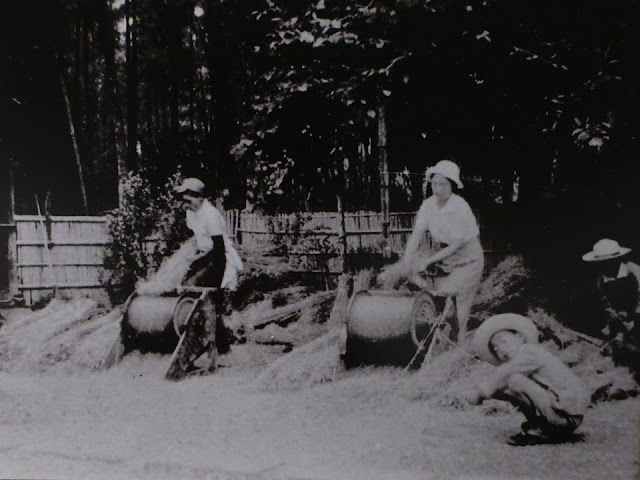Noda is 30km north of the central Tokyo; it is the birthplace of Kikkoman (the
largest soy sauce manufacturer). The museum in the ground of the soy sauce
brewer's mansion; it was donated to Noda city. The lives of Noda people such as
soy sauce manufacturing are explained well, although it doesn’t mention the fun
of Noda people a lot.
It is a bit smaller than a school gymnasium. The permanent exhibition of the ancient era and the special exhibition “People lived in Noda” were held in the 1st floor, and the permanent one mainly about soy sauce manufacturing is held on the 2nd floor when I visited.
学校の体育館より少し小さいぐらいの展示スペースです。一階が古代の常設展、企画展「野田に生きた人々」、二階が醤油作りを中心にした常設展でした。
Ancient period、古代の展示
The clay pots are shown together with equivalent kitchenware. They don’t change so much.
縄文土器を、今の調理器具と並べているのが、いいですねえ。
The stone equipment were used to grind down nuts or something. They also don’t change so much.
磨石(すりいし)と石皿。縄文時代の品です。誰かが、一生懸命に木の実を砕いたのでしょう。こちらも分かりやすい。あまり進化していませんね。
The clay dolls always relax our minds as well as ancient people's ones.
土偶は、つくった人、持っていた人の気持ちが伝わって、やっぱり、いいですね。
Pre-modern and modern period。近世・近代の展示
Lives and culture since the 18th century when the large-scale soy sauce manufacturing started are introduced.
醤油醸造が本格的に始まる江戸時代中期から昭和30年代までの約350年間の生活と文化が紹介されています。
The ranking of soy sauce brewers in eastern Japan are listed. In 1840, more than ten brewers from Noda were ranked in.
関東醤油番付(1840)には、野田の醤油屋さんが10家以上ランクイン。
The signboards said that the shop supplied to the Edo castle and Tokugawa shogun’s relatives. They showed the high quality to ordinary people.
御本丸西御丸御用額(左、1854)と御三卿に醤油を納めていたことを示す田安一橋清水御前御用額(1835)
The soy sauce factory by manual manufacturing (until the late 19th century)
手作業で醤油を作っていた頃(19世紀末まで)の醤油蔵の模型
In 1917, eight brewers were merged and “Noda soy sauce” established; it changed the name to Kikkoman later. Noda has prospered as a company city.
1917年に、醸造家八家が合同し、キッコーマンの前身・野田醤油株式会社ができました。野田は、企業城下町として発展します。
Wooden containers (barrels) were used until around 1950’, so there were many craftsmen who made them.
缶や瓶が主流になる昭和30年頃まで、樽を作る職人さんがたくさんいたそうです。
Assembling、結い立て
Farming and its equipment、農機具や農業の写真
Threshing on the straw sheets. Adorable children played around it.
蓆を敷いた上での脱穀作業。子どもが可愛らしいですね。
Special exhibition “People lived in Noda”、企画展「野田に生きた人々」
Water transportation was major before trucks took the place. There were many ships on Edo River even in 1920’. The picture relaxes me. I like the person in the boat.
風景画の錦絵で人気を集めた高橋松亭の「せきやど」(1920年代)。この地域を題材にした絵も多いそうです。トラックの前は、水上輸送でした。ホッとさせられる絵ですね。小舟の人がいいです。
The Ema (picture board) of Kobuuchi Hachiman Shrine shows Hachiman god beats demons and villagers pray beside the god. The dysentery spread in 1897, so villagers prayed to the god; soon after, the plague finished. Therefore, people offered the board to the shrine and thanked to the god. They asked for help to a god if they couldn’t control a trouble.
古布内八幡神社・八幡神鬼退治絵図。1897年、赤痢が流行しました。神社に祈願した所、たちまち収束に向かったので、絵馬を奉納したと書かれているそうです。村人が手を合わせ、八幡神が鬼(疫病)を退治しています。手に負えない物は、神頼みです。
A samurai of Noda wrote the books “Inaka (countryside) Soushi (book)” in 1727. It is an almost manga book.
関宿藩(野田)の藩士が書いた田舎草子(1727)。悪いネズミを退治できなかった若い猫たちに老猫が足りない所を教える「猫の妙術」が有名で、剣術指南になっているそうです。ほとんど漫画ですね。
Civic Center、市民会館
The former brewer Mogi’s mansion, which was built in 1924, is utilized as a civic center. It’s good open to the public.
茂木氏の旧宅は市民会館になっています。素敵ですね。1924年頃に建てられました。
Kikkoman factory、キッコーマンの醤油工場
Visited in November, 2020
Official website: https://noda-muse.jp/ (in Japanese), accessed
in January, 2022
Previous post (Museum in the neighboring city): Kashiwa
City Local Historical Artifacts Room、柏市郷土資料展示室
Next post (Museum
in the neighboring city):


























Comments
Post a Comment